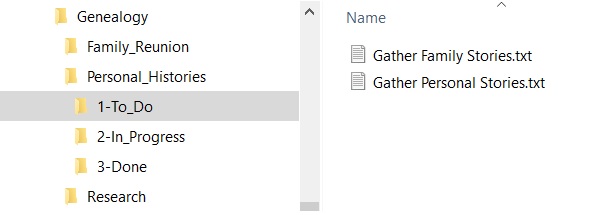Organize Yourself Electronically
By Dale E. Lee
2022.09.14
In the past I’ve discussed how to organize your paper documents and computer data. Here I’ll discuss how to organize yourself electronically. Organization is one of the most important things you can do in Family History, as in most efforts. The lack of organization can greatly degrade your ability to accomplish tasks.
There are many applications on the market that offer help with organization. The following are only some of the ways to organize. Examples of the kinds of methods and apps are given below, but are no means a comprehensive list of them. Do your due diligence when researching the tools that are applicable to your own situation.
- Articles (eg. Pocket, Articles +)
- Bills (eg. 24 me, Quicken)
- Calendars (eg. Android’s Calendar, Google Calendar)
- Fitness (eg. My Fitness Pal, Fitness Planner)
- Internet of things (eg. IFTTT)
- Notes (eg. EverNote, OneNote)
- Social Media Posts (eg. Hootsuite, MailerLite)
- Tasks (eg. Trello, Microsoft To-Do)
- Trips (eg. TripIt, Trip Planner)
- etc.
Since we are mainly interested in organizing Family History, the following discussion deals with task organization. The examples described below can be used if desired, but they are given here to illustrate the basic functionality that more high powered apps provide. The functionality will be shown by the use of Windows directories and files.
Project planning can be implemented with the use of high powered business tools, such as PERT Charts and other project planning tools (eg. Monday.com), or by way of tools geared toward individuals, such as the tools mentioned above. A very simplified means of illustrating the basics will be shown for the concepts of Groups, Sequence, Projects and Tasks.
For example, we could create a directory for our Genealogy Projects by labeling a directory “Genealogy”. Then we can group the kinds of things we want to do in sub-directories representing “Groups”, such as “Family_Reunion”, “Personal_History” and “Research”.
Each of the “Groups” we’ve created with directories can track “Sequence”, also with the use of directories. The directories “To_Do”, “In_Progress”, and “Done” below simulate the use of Sequence to track the progress of Tasks through the completion cycle. The numbers 1-, 2- and 3- have been added to the names to order them properly.

Each level in the completion cycle can be further broken down into the “Projects” we want to complete. Projects, such as “Gather Family Stories.txt” or “Gather Personal Stories.txt” above are shown using computer files within the Sequences.
And each of the Projects can be broken down into the specific “Tasks” we want to complete within the Project. The following Task information is recorded in the Project “Gather Personal Stories” file in the “To_Do” Sequence:
Project: Gather Personal Stories
Tasks:
4) Use the Suggestion section at the bottom of Seekerz’ Personal Histories post to remind you of things that have happened in your life http://www.seekerz.net/personal-histories/
5) Create a simple Pedigree Chart
6) Create a final version of the Personal History
Note that once the work is begun, it is taken from the To_Do Sequence and moved to the In_Progress Sequence Project with the same name (Gather Personal Stories).
The following is the Project “Gather Personal Stories” in the In_Progress Sequence. As you can see only one Task is currently in progress, but more than one could have been.
Project: Gather Personal Stories
Tasks:
3) 2022.09.10 – Think about and document memorable events in your life
When the Task is completed, it is moved to the “Done” Sequence for the same Project.
The following is the Project “Gather Personal Stories” in the Done Sequence:
Project: Gather Personal Stories
Tasks:
1) 2022.07.01 – Ask members of the family what they remember about you
2) 2022.09.01 – Create a timeline of your life
Note that when the Task is started, we add a start date to it in its Project in the In_Progress Sequence and when it is completed we change the date to a completion date in its Project in the Done Sequence.
This is a very simple example of how individual task management apps might work, but they will probably include additional functionality such as:
- Clicking and dragging of tasks from one Sequence to another
- Cross platform syncing
- Drag and drop
- Reminders
- Collaboration
- Coordination with calendars
- Etc.
Whatever level of organization you need, from a simple to do list, to the example above, to the use of software like Trello or even monday.com, be sure you measure your needs and compare them to the functionality these apps provide. Finding the right level of organization is critical to accomplishing your objectives. And the ability to organize will always help you accomplish those objectives more quickly and efficiently than disorganization.
—
Seekerz LLC, © 2022
